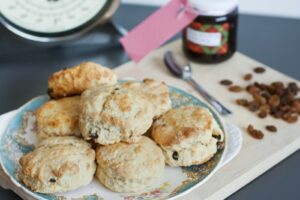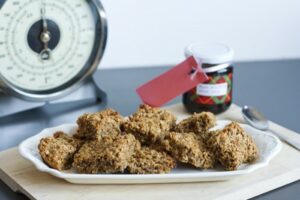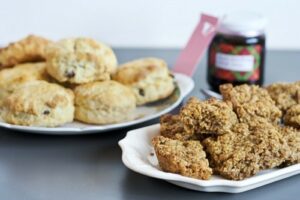 Sally Jack is a writer and poet based in Leicester. She has just completed a degree and during her time at university was the food columnist in The Demon newspaper. These are a selection of her recipes – aimed at students but suitable for all. Sally enjoys writing feature articles and fiction for children and grown ups, however, she also has a keen interest in poetry, art, theatre and local history. And food – cooking it, sharing it and writing about it.
Sally Jack is a writer and poet based in Leicester. She has just completed a degree and during her time at university was the food columnist in The Demon newspaper. These are a selection of her recipes – aimed at students but suitable for all. Sally enjoys writing feature articles and fiction for children and grown ups, however, she also has a keen interest in poetry, art, theatre and local history. And food – cooking it, sharing it and writing about it.
Bringing Home the Baking
For many people home baking is an important family heirloom. Both my grandmothers and my mother were keen cooks and more than happy to share their knowledge. I was probably the same age as my daughter (eight, but less messy) when my Grandma taught me how to make scones. She had a set of ‘proper’ scales, now in my kitchen, and it was my job to select the right weight, carefully measure out each ingredient and check it balanced. I wore her pinny, knelt up on her kitchen stool and we worked in quiet efficiency to produce a batch of golden-topped, perfectly risen scones for tea.
The good thing about scones is you can get a batch on the table within 45 minutes (my current personal best time). Although I subscribe to the ‘a bit of this, a squirt of that’ method of cooking, one thing with baking is not to guess weights of ingredients (it’s the ‘science bit’). I recommend investment in a set of scales – these can be purchased very cheaply in the market, no need for anything fancy and of course very handy for future baking sessions.
The flapjack is based on a recipe my mum used to make every week but I add honey – it’s much better!
Happy baking.
Grandma’s Scones
 Plain or fruity? If you want to do both divide the mixture in half before adding the fruit. Best eaten the day they’re made, warm from the oven and smothered in butter and jam. Yum. For 8 scones:
Plain or fruity? If you want to do both divide the mixture in half before adding the fruit. Best eaten the day they’re made, warm from the oven and smothered in butter and jam. Yum. For 8 scones:
- 8oz (225g) self raising flour
- 1-1/2 oz (40g) butter/marg
- pinch of salt
- 1oz (25g) caster sugar
- ¼ pint (150ml) milk
- sultanas – 2oz/50g, adjust as preferred
Method
- Preheat oven to 220C /Gas 7. Lightly grease a baking sheet or line with baking paper.
- Sieve flour into a bowl. Cut butter into small squares and rub into flour until it resembles fine breadcrumbs.
- Add salt and stir in sugar. If making a mixture of plain and fruit scones, divide mixture into two bowls.
- Add fruit if using, to whole or half mixture.
- Gradually add milk, a little at a time – mix first with a knife then gently bring together with your hands. You need to make sure the dough doesn’t get too sticky and this is easier to judge by hand.
- Once you have a soft dough, turn out onto a floured surface. Don’t knead it – it makes the scones tough. Gently press the dough to about 2 – 3cm thick.
- Using a cutter or upturned mug, cut out scones – reshape dough until it is all used.
- Arrange on baking sheet, brush tops with a little milk (if you don’t have a brush, the back of a teaspoon works just as well).
- Cook for about 10 -12 minutes. Cool on a wire rack.
Sally Jack’s Flapjack
 This is very easy! You could also add chopped apricots, sultanas or raisins before cooking or drizzle the top with melted chocolate (once it has cooled).
This is very easy! You could also add chopped apricots, sultanas or raisins before cooking or drizzle the top with melted chocolate (once it has cooled).
- 8oz (225g) oats (rolled or porridge)
- 6oz (175g) butter/marg
- 4oz (110g) dark brown sugar
- 1 tablespoon honey
Method
- Preheat oven to 180C/Gas 4
- Grease a small roasting tin, 7” square cake tin or 2 round Victoria sandwich tins
- Slowly melt butter in a saucepan and add honey
- Meanwhile mix oats and sugar in a large bowl. Crumble any lumps in the sugar
- Once the butter and honey are melted add to the oats and stir until thoroughly mixed
- Press evenly into tin(s) and bake for 12 -15 minutes. The edges of the flapjack will look crisp and cooked.
- Remove from oven, mark out the flapjack into slices but don’t remove from the tin until it is cool (it needs to ‘set’ and will just crumble and break if you try to remove before it has cooled down)

Recipe by Sally Jack
Photographs by Briony Latter

Leave a Reply